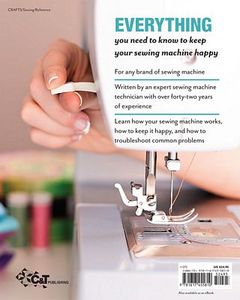Author: Bernie Tobisch.
144 pages.
You and Your Sewing Machine: A Field Guide by expert machine technique Bernie Tobisch. This 143-page instructional guide offers troubleshooting, maintenance, sewing tips, and techniques for sewists of any age. This must-have guide can be used with any brand and model sewing machine. Learn the difference between mechanical, electronic, and computerized sewing machines as well as what questions to ask when purchasing a new sewing machine. Learn the basics of caring for your machine so that it remains in good working order for years to come. Bernie Tobisch guides you through the uses of the most common presser feet. Build a better relationship with your sewing machine with You and Your Sewing Machine: A Field Guide.
You and Your Sewing Machine: A Field Guide by expert machine technique Bernie Tobisch. This 143-page instructional guide offers troubleshooting, maintenance, sewing tips, and techniques for sewists of any age. This must-have guide can be used with any brand and model sewing machine. Learn the difference between mechanical, electronic, and computerized sewing machines as well as what questions to ask when purchasing a new sewing machine. Learn the basics of caring for your machine so that it remains in good working order for years to come. Bernie Tobisch guides you through the uses of the most common presser feet. Learn how to sew and build a better relationship with your sewing machine with You and Your Sewing Machine: A Field Guide.
Contents:
Introduction
Getting to Know your Sewing Machine:
How a Stitch is Formed
Sewing Systems and Hook Types
Mechanical versus Electronic versus Comupterized
Sewing Machines Motors: AC vs DC
Needle Plates
Knee Lifters
Foot Controls: Rheostat vs Electronic
Bobbins: Cases and Sensors
Feed Dogs: Boxed vs Elliptical Feed / Dropping the Feed
Questions to Ask when Buying a New Sewing Machine:
Questions
Testing the Machine
Buying Online vs from a Dealer
Using the Right Foot:
Embroidery or Applique Foot
Walking Foot
Edge-Stitch Foot
Free Motion or Daring Foot
Cleaning and Lubricating:
The Lower Part of the Machine
The Upper Part of the Machine
Lubrication
Other Maintenance:
Firmware Updates
Mechanical Updates
Surge Protectore
A Few other Things
Tension in the Relationship:
Top Tension
Bottom (Bobbin) Tension
Tension Calibration and Adjustment
Things that might Affect Tension
It's Hardly Ever the Tension:
Smoothing Burrs on the Hook
Thread
Damage to the Bobbin Case
Incorrect Threading
Needle Plate Damage
Spool Pin Orientation
Bobbins
Needles, Threaders, and Automatic Thread Cutters:
Needles
Anatomy of a Needle
Important Relationships: Needle Sizes, Threads, Stitches
Choosing Needles by Quality or Price
When to Change Needles
Twin, Triple, and Hemstitch/Wing Needles
Machine Needle Threaders
Automatic Thread Cutters
Troubleshooting Thread Cutters
Presser Foot Pressure Adjustment:
Location of Adjustment
When to Adjust Pressure
Forward/Reverse Balance AdjustmentP:
Where is the Adjustment
When to Adjust
Buttonholes:
Buttonhole Systems
Troubleshooting Buttonholes
Making Great-Looking Buttonholes
Troubleshooting Guide:
Index:
About the Author:
















































